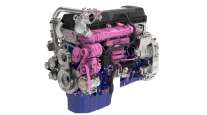Senior Reporter
Truck Manufacturers Group Files Lawsuit Seeking More Lead Time for CARB Regulation

[Stay on top of transportation news: Get TTNews in your inbox.]
The Truck and Engine Manufacturers Association filed a federal lawsuit May 27 alleging that California environmental regulators have failed to give manufacturers enough lead time to meet the state’s new, more rigid emission standards.
In its lawsuit, filed with the U.S. District Court for the Central District of California, EMA alleges that the federal Clean Air Act requires that manufacturers be given “four full model years” of lead time before new emission standards become effective.
The manufacturers said that the California Air Resources Board gave them only two years.

“On Dec. 22, 2021, CARB adopted the Heavy-Duty Engine and Vehicle Omnibus Regulation, a package of stringent emission standards, test procedures and other emission-related requirements applicable to new heavy-duty on-highway engines and vehicles sold in California,” EMA said in a statement. “The Omnibus Regulation requires heavy-duty engine and vehicle manufacturers to comply with the new standards on Jan. 1, 2024, providing manufacturers only two years of lead time.”
EMA said the Omnibus Regulations would require engine manufacturers to redesign, test and build their engines to comply with all of the new requirements.
“This lawsuit is simply to ensure that CARB follows all of the prescribed rules — one of which is intended to maximize the likelihood of the smooth and successful implementation of new emission standards,” EMA President Jed Mandel said in a statement.
Specifically, the lawsuit asks the court to declare that the provisions of the Omnibus Regulations that would take effect starting in MY [model year] 2024 are invalid and unconstitutional under the Supremacy Clause of the U.S. Constitution “insofar as they would apply prior to MY 2026.”
The new rule drew support from state air quality officials nationwide, but was opposed by EMA and some trucking industry trade groups, including American Trucking Associations and the California Trucking Association.

The new regulation reduces the current heavy-truck NOx standard from 0.20 grams per brake horsepower hour to 0.050 g/bhp-hr from 2024 to 2026, and to 0.020 g/bhp-hr in 2027.
The regulation also lengthens the useful life and emission warranty of heavy-duty diesel engines for use in vehicles with a gross vehicle weight rating greater than 10,000 pounds. The stringent NOx emission standards begin with the 2024 model year engines and become more stringent with 2027 and subsequent model year engines.
“The highly diversified and low-volume commercial engine and vehicle manufacturing industry must design multiple new engine and exhaust aftertreatment technologies, conduct extensive testing to ensure long-term durability, integrate the new systems into extensive distinct vehicle chassis and assure customers that the new products will meet their needs through real-world demonstrations,” EMA’s statement said.

Kedzie
“EMA’s challenge has merit in that the federal Clean Air Act requires four full model years of lead time from adoption of a new emission standard to its implementation date,” said Glen Kedzie, vice president of energy and environmental counsel for ATA. “ Such lead time is critical to give manufacturers the ability to financially plan and undertake the necessary research and development needed to engineer solutions to meet any new standard. Congress never intended to afford CARB a lower lead time threshold than that of EPA. To draw such a conclusion is baseless.”
CARB said it could not comment on the pending litigation, but said in a statement, “We can say that of all the measures we rely on to achieve healthy air, the heavy-duty Omnibus Regulation targets the largest contributor of NOx emissions (on-road heavy-duty emissions account for 31% of total NOx emissions) and is expected to provide the most NOx emission benefits to help the state reach its federal air quality standards.
“These NOx reductions are the equivalent of taking 16 million light-duty cars off the road, resulting in nearly 4,000 avoided premature deaths and 3,150 avoided hospitalizations statewide over the life of the rule. The rule will also have total statewide health benefits of approximately $36.8 billion and most greatly benefits those disadvantaged communities living in close proximity to heavy truck traffic.
“The benefits of this regulation will be particularly important in California’s most environmentally and economically burdened communities, whose residents live in the shadow of freight terminals, and whose neighborhoods line the busiest freight corridors in the state. It is appalling that anyone would try to weaken this rule.”
Want more news? Listen to today's daily briefing below or go here for more info:




